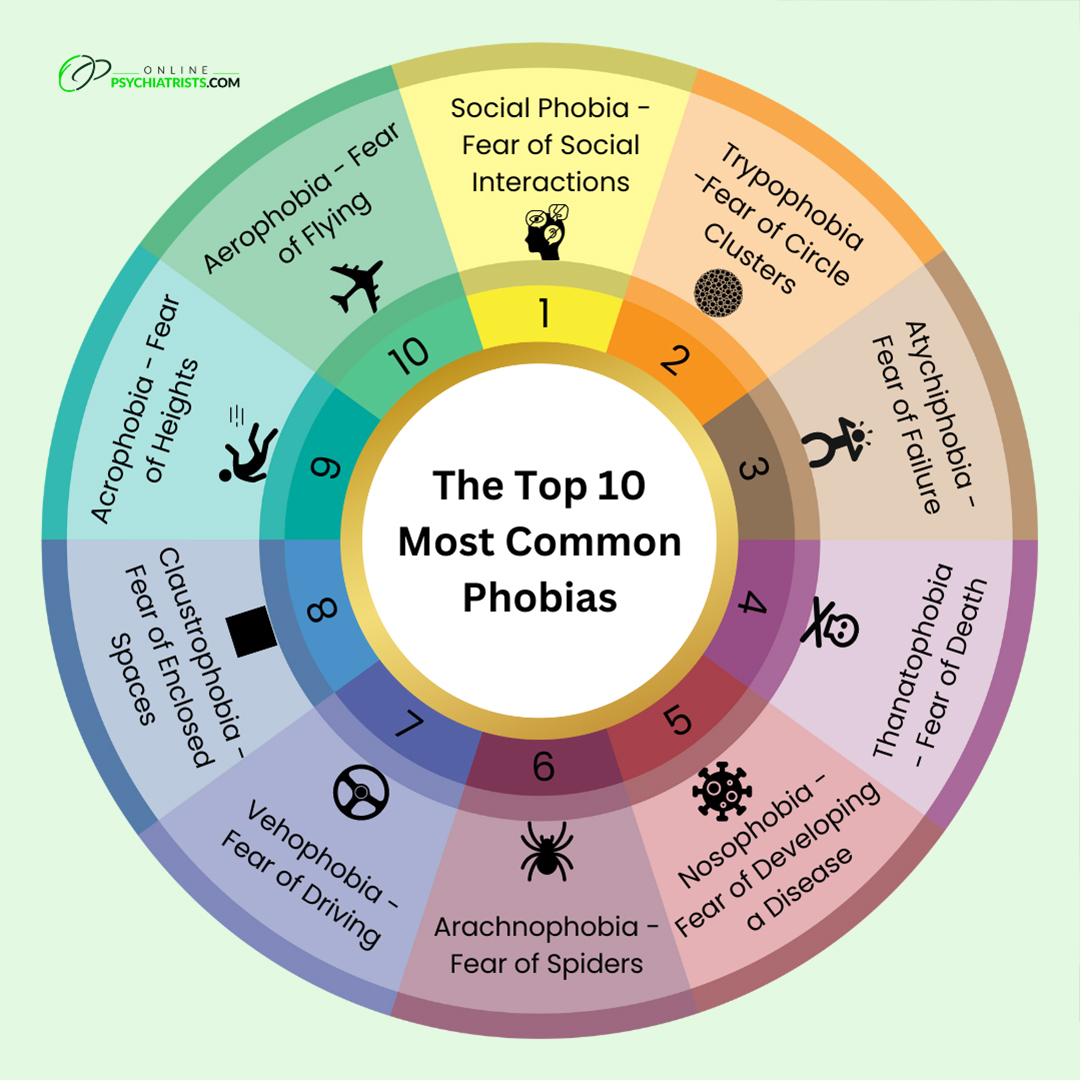

Phobias can affect your mental health and well-being, especially if they involve something you come across often. You may end up limiting your movement, miss important opportunities and live in constant fear to avoid encountering your phobia. Overcoming phobia may be difficult, but with the right help, you can learn to manage your apprehensions and lead a productive, fulfilling life. Schedule an appointment with Dr. Zlatin Ivanov to take control and move forward with confidence. He focuses on the factors, including the symptoms and severity of the phobias, and recommends psychotherapy, anxiety medication, or a combination of both to ensure you find permanent relief from the debilitating symptoms.
Phobias are distressing emotions that cause out-of-proportion anxiety or excessive and persistent fear of real and imaginary objects, events, or situations. Individuals with phobias often go to great lengths to avoid coming in contact with the circumstances or objects they fear. In extreme cases, phobias can turn unbearable or life-threatening and even cause physical symptoms like sweating and chest pains.
While many people find phobias unusual or even unrealistic, to a sufferer, a phobia can create a significant disruption to normal functioning and well-being. The good news is phobias are treatable conditions that can be minimized or eliminated with cognitive and behavioral therapy and medications.
Discussed here are the top 10 most common phobias that people suffer from. Read on to discover and learn more about the phobias that can make life difficult.

People suffering from social phobia fear being around other people or social situations that are likely to trigger an anxiety attack. Social phobia often develops during puberty, can last throughout life, and turn quite serious if it is not addressed the right way. It usually stems from low self-esteem and fear of being watched or embarrassed in front of other people.
Also known as social anxiety disorder, social phobias are the most common fear observed among people. Social anxiety disorder can make everyday interactions challenging, stressful, and anxiety provoking. Social phobia can affect an individual’s well-being and ability to function normally, like attending school, making friends, and keeping a job or forming lasting relationships.
Trypophobia is fear or aversion to objects like honeycombs and sponges with repetitive patterns or clusters of small homes. It may seem extreme or irrational, but studies reveal that many people have a very real struggle with trypophobia. The mere sight or thought of holes can set off a panic attack.
The image of clusters brings up memories of things humans fear, like infectious diseases and dangerous insects like bees. People with trypophobia are disgusted or repulsed by the pattern of holes, even though they may not have a fear of holes. They go to all lengths to avoid pretty much everything that has holes in them, such as coral, sponges, skin, meat, dried honeycombs, and anything else resembling them.
Atychiphobia is the intense fear of failure. It comes from the Greek word atyches, which means unfortunate. It affects an individual’s ability to function in daily life. People with this phobia try to avoid situations where they see potential for failure, such as an exam or a job interview, or postpone a task as they are afraid of not achieving them.
While all of us are afraid of failure at some point in life, people suffering from this phobia face extreme fear of not being able to progress. Atychiphobia may be part of a more general social phobia or a type of anxiety disorder that turns debilitating if it is not addressed timely.
Thanatophobia is an intense fear of death or the dying process. Fearing death is not unusual. It is natural to feel anxious about dying from time to time, but if it takes over day-to-day activities and causes extreme anxiety that disturbs normal routines and behavior, it becomes a serious problem.
Thanatophobia is a type of anxiety disorder that can disrupt every aspect of life. Particular triggers could include some early traumatic event related to a near-death experience or the death of a loved one. Any individual who has been through severe illness may experience thanatophobia as the developed anxiety about dying, but ill health is not necessary for a person to experience fear of death.
It is the persistent, irrational fear of contracting some chronic, even life-threatening diseases like cancer or AIDS. It is similar to hypochondria, a type of anxiety disorder that makes people worry about their health now and then, but nasophobia is constant anxiety about minor symptoms and fear of a more serious condition.
Nosophobia often results from past traumatic medical events, exposure to media coverage of epidemics or other serious health problems, and reading about medical conditions at work or in school. According to experts, due to the COVID-19 global pandemic, the fear of developing the disease has been intense over the last few years, and it has affected many people with this phobia.
Read more: What Is The Difference Between Mental Health & Emotional Health?
Arachnophobia is the fear of spiders and other arachnids, such as scorpions. For some people, the sight of a spider can cause a fear response, but in some cases, just an image or even a thought of a spider can lead to overwhelming fear and panic.
The excessive fear of spiders is linked to the evolutionary response against these creatures, as many of them are poisonous. There was a time when these creatures posed a threat to our ancestors as they lacked the knowledge and tools to deal with injuries from spider bites. Even though most spiders are harmless, a person with this phobia may still panic or feel uneasy around one.
Symptoms of arachnophobia mostly appear during childhood, but they can also develop into adulthood, particularly after some incidents involving interaction with spiders. As with other phobias, anxiety from this specific fear can lead to physical symptoms disturbing normal life and behaviors.
It is the intense and excessive fear of driving, often on highways or bridges. People who suffer from this phobia make efforts to avoid getting behind the wheel, and even if they are forced to drive, they experience extreme anxiety, difficulty breathing, increased heart rate, and fear throughout the process.
This phobia is often similar to the symptoms of Acute Stress Disorder or PTSD, depending on their individual experience. It has been noted that some people with vehophobia may be able to travel comfortably in a motor vehicle as a passenger but faces extreme distress, discomfort, and panic when faced with the possibility of driving a car.
Claustrophobia is a type of anxiety disorder that causes intense fears of restricted or confined spaces and includes symptoms such as difficulty breathing or fear of running out of oxygen. Studies reveal that several people suffer from claustrophobia, which makes them nervous about being suffocated in a tight, enclosed space.
Some people with this phobia can also experience extreme anxiety on airplanes and busy venues like shopping malls, crowded elevators, or other closed-up areas as they feel trapped. They tend to feel fear of what might happen to them in a confined space which leads to the sense of oxygen not being adequate. Even thinking about it or being confined can trigger a fear of not being able to breathe adequately.
It is the fear of heights or falling from a height. While it is normal to have some degree of dread when encountering heights, this phobia involves intense fear that can result in panic attacks and avoidance behavior. People with acrophobia often go to great lengths to avoid high places such as bridges, towers, or tall buildings.
Some people suffer from acrophobia as a result of past traumatic events, but research also suggests that it could be caused by a survival mechanism or parents’ overreaction. In severe cases of acrophobia, even the simple act of climbing up and down a chair, thinking about crossing a bridge, or seeing a picture of a mountain and surrounding valley can lead to panic attacks and cause extreme agitation.
Read more: Everything You Need To Know About Couples Therapy
The fear of flying sometimes causes people to avoid flying altogether as they feel intense anxiety before or during the light. This condition can interfere with their ability to travel for work or pleasure. Common symptoms associated with this phobia include trembling, rapid heartbeat, chest pain, sweating, dryness in the mouth, sudden intense fear, and feelings of disorientation. It is often associated with other fears, like the fear of closed spaces or fear or heights.
While it may result from seeing excessive plane and helicopter accidents in media or fear of heights, it can also be passed down from parents if they are anxious flyers. Most people experience a panic attack, especially when confronted with the source of the problem, or when they are asked to sit in a plane.
Do not let your fear or phobias keep you from activities you love. Whatever phobia you suffer from, it is completely valid and should not be ignored or brushed aside. If a phobia is interfering with your daily routine, there are ways to get help, and you can look forward to living a normal, phobia-free life with professional guidance and support. Call our psychiatry practice now to learn more about treatment options that focus on the symptoms and severity of the phobias you are experiencing to relieve your discomfort. Dr. Zlatin Ivanov works with you to develop a personified treatment plan that meets your unique needs and goals, reduces your fear of phobic conditions, and helps reclaim the freedom to live better.

Dr. Zlatin Ivanov, MD, is an adult psychiatrist specializing in addiction treatment, ADHD, anxiety, depression, and OCD. He offers exceptional talk therapy and medication management through online video conferencing.
Dr. Ivanov is double board certified in Psychiatry and Clinical Neurology and a member of the American Psychiatric Association. His medical career is colored by many outstanding contributions to medicine, including several publications, research, and scientific presentations. An attending psychiatrist at Woodhull Medical Center in Brooklyn, NY, and Bellevue Hospital Center in New York City, he takes the time to listen to patients and makes sure they know he is committed to their unique situation.
 Our Locations
Our Locations
The Chrysler Building
405 Lexington Ave, #2601
New York, NY, 10174 (map)
300 Carnegie Center Drive #150K,
Princeton, NJ, 08540 (map)
701 Brickell Avenue, 1550#A,
Miami, FL, 33131 (map)